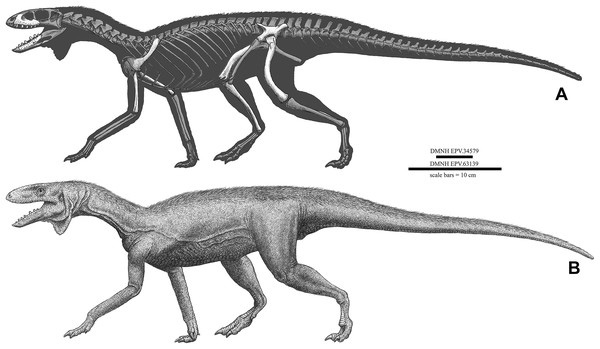Non-dinosaurian Dinosauromorphs from Colorado Discovered
Kwanasaurus williamparkeri – The Newest Member of the Silesauridae
Dinosaur discoveries usually grab all the headlines. However, our attention was caught recently with the publication of a scientific paper in the academic journal “PeerJ”, describing a new species of silesaurid, a Triassic reptile that was so very closely related to the Dinosauria, but not quite a dinosaur. The animal has been named Kwanasaurus williamparkeri and it roamed what was to become Colorado some 210 million years ago.
Studying Dinosauromorphs
A Skeletal Reconstruction and a Life Reconstruction of Kwanasaurus williamparkeri
Picture credit: PeerJ/Jeffrey W Martz and Bryan J Small
The picture (above), shows (A) a skeletal reconstruction with known fossil elements shaded light grey. The skeletal reconstruction is based on the fossilised remains of several individuals all scaled to the same size. The body plan is based on Silesaurus. Note the scale bars equal ten centimetres given for probable largest specimen (DMNH EPV.34579) and one of the smallest specimens.(DMNH EPV.63139).
From the Upper Triassic Chinle Formation of Colorado
Numerous fragmentary fossils representing parts of the jaw, limb bones and possibly a scapula and lower leg bones along with isolated teeth have been found in the “red siltstone” member of the Upper Triassic Chinle Formation (Eagle Basin, Colorado).
The strata were deposited in the Late Triassic (215-207 mya – middle to late Norian. Kwanasaurus is the northernmost silesaurid known from the Americas and only the fourth taxon recognised from North America, although more specimens of silesaurids are likely to be found in the future, after all the Silesauridae was only formally erected in 2010. In addition, the authors of the paper, report on the discovery of fossils ascribed to Dromomeron romeri, a bipedal member of the Dinosauromorpha but from another branch (the Lagerpetidae), thus, we have two non-dinosaurian dinosauromorphs from these sediments. This is the first documented occurrence of D. romeri from the Chinle Formation of the Eagle Basin of Colorado
Upper Jawbone (Maxillae) and Accompanying Line Drawings – Kwanasaurus williamparkeri
Picture credit: PeerJ
“Eagle Lizard” – Probably a Herbivore
The genus name means “eagle lizard” honouring the town and county of Eagle, as the fossils were found nearby. The trivial epithet honours Dr William Parker, a vertebrate palaeontologist who has helped develop our understanding of Triassic archosaurs. These types of archosaurs were contemporaneous with the first dinosaurs and the discovery of Kwanasaurus adds further support to the theory that for millions of years different types of archosaurs co-existed and that the Dinosauria did not have a sudden rise to ecological dominance. The robust jaws and the teeth indicate that Kwanasaurus was probably herbivorous, this suggests a dietary specialism amongst silesaurids as most other genera are believed to have been omnivorous.
Views of the Left Dentary (Lower Jaw) of K. williamparkeri with Accompanying Line Drawings

Picture credit: PeerJ
The scientific paper: “Non-dinosaurian dinosauromorphs from the Chinle Formation (Upper Triassic) of the Eagle Basin, northern Colorado: Dromomeron romeri (Lagerpetidae) and a new taxon, Kwanasaurus williamparkeri (Silesauridae)” by Jeffrey W Martz and Bryan J Small published in PeerJ.
The Everything Dinosaur website: Everything Dinosaur.



